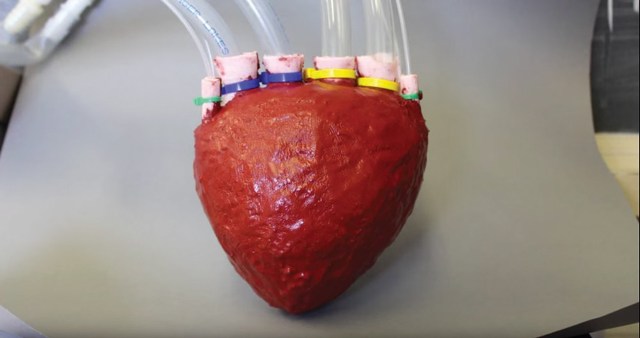Jan 28 2016
If you think of a robot, you’re probably picturing C-3PO, Ultron or Wall-E. But what if robots don’t need to be big, humanoid and upright? What if they aren’t even made of metal?
 Courtesy of The Organic Robotics Lab
Courtesy of The Organic Robotics Lab
The Organic Robotics Lab in Kimball Hall, headed by Prof. Robert Shepherd, mechanical and aerospace engineering, focuses on creating such robots. They use soft materials to replicate movement and functions from organisms already found in nature.
“We make new types of actuators — things that move; and we make new types of sensors — things that feel; and new types of manufacturing processes that integrate the two in ways that is not done in traditional robotics,” Shepherd said.
After getting some exposure to robotics at Harvard, Shepherd realized that robots could be made from new materials, for him, rubber did the trick. Rubber is flexible and moldable, hence offers a world of potential.
“If we can use rubbers to make robots, we can use liquid state processing on them,” he said, “So we can cast parts instead of having to machine them, and we can more quickly make robots that can do more things.”
Using organic materials instead of metal to build robots has two advantages. First, they can be processed in the liquid state, and so can be molded as required. And second, because they are carbon-based materials, they have mechanical properties of natural organisms.
And so now, animals can inspire new robots. While replicating complex animals like an octopus is still a challenge, replicating simpler life forms is a definite possibility, according to Shepherd.
“We can start working simply and then once we develop more intricate manufacturing processes and better materials we can move up to more sophisticated life forms,” Shepherd said.
Effective application of the lab’s research can produce life-changing results. For example, the foam heart actuator developed in the lab can pump a higher rate of fluid than any other soft artificial hearts. Though creating an actual artificial heart for humans is likely decades away for the lab, there are several other current projects within reach.
“There’s no approval for testing on real animal models or anything, so we can’t use that [3-D heart actuator] today. What we could do is make prosthetics for people who’ve lost a limb or hand,” Shepherd said. “We’re working on orthotics – wearable actuators that could help with motion, or help retrain stroke patients.”
According to Shepherd, the lab is not focused on clinical trials yet.
“At this point, our group is staying away from clinical and other things like that, just because there is a lot more to do in the fundamental side,” he said. “We’re relying on other people to take up practical usage and start implementing them. I think prosthetics could be some place where we can have immediate impact.”
Apart from creating and studying soft robots, the lab also works on introducing them to children. The lab’s website boasts that the conversion of “the iterative design and manufacturing process” developed in Shepherd’s courses and research into an instructional resource, is a primary goal.
The lab has a program where members of the team go out and conduct a demonstration to elementary school and middle school kids on building fairly simple soft robots.
“We go there with 3-D printed molds and then we have them put dough in the molds and … assemble their actuators,” Shepherd said, “Sometimes they work, sometimes they don’t — depending on how much care the children take in making them… When they do work, they really like it.”
The lab has also developed foam-based robots which will make building soft robots more accessible for children. This will be like sculpting a robot and wouldn’t require any member of the lab to teach them.
In the future, Shepherd said that the lab will focus less on building the actual robots and more on putting the process into place.
“Right now, we’ve started to move a lot into building actual robots, but I think what we’re going to do is go back to the basics and continue working on the materials to simulate natural materials and organs,” Shepherd said. “How animals work is by a complex interplay of organs. We want to work on replicating that synthetically, and then hand these new machine and sensors to roboticists to actually build a robot.”
Speaking of the future, Shepherd said he is optimistic about the lab and the field of soft robotics in general.
“When you take really good students, like you get at Cornell,” Shepherd said, “and you put them in an area where there is a lot of space to move, you can end up going in a lot of different directions.”